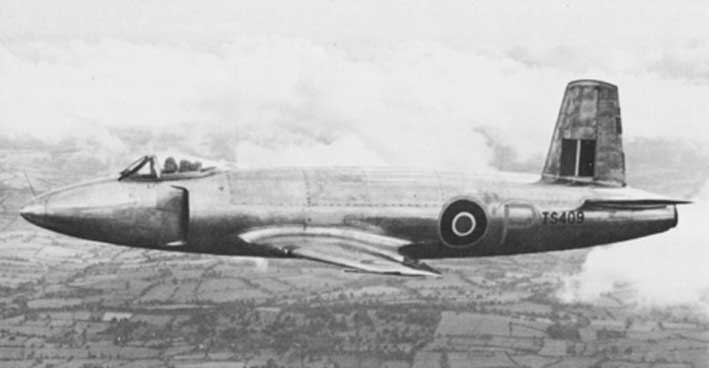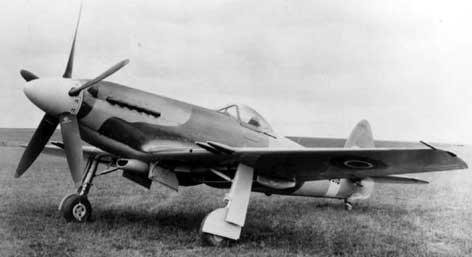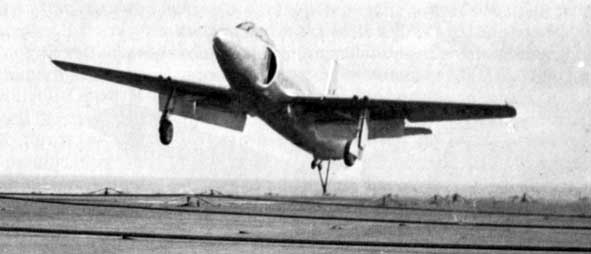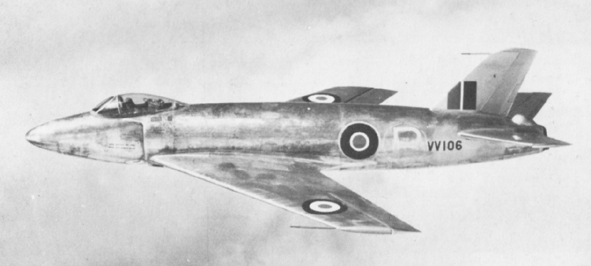

| In early 1944 the Supermarine Aircraft company was asked by the British Government to design a fighter around the proposed new engine from Rolls Royce the R.B.40 (specification E.1/44). On the 5/8/1944 Supermarine received a contract from the British Ministry of Aircraft Production for three "jet machine of the Spiteful type" to specification E.10/44, this resulted in the Type 392, fitted with a laminar flow wing design based on the Spiteful wing (which had yet to make it's first flight) and powered by the new Rolls Royce R.B.41"Nene" engine. Because of the use of the Spitful's wing the design of the type 392 was of a conventional lay out with the aircraft being fitted with a tail wheel. However there was no RAF interest from the start, but the design was developed as the Type 398 "Attacker" for the Royal Navy to specification E.1/45, who placed an order for 24 pre-production "Attackers" on the 21/11/1945. |
 The Supermaine "Spiteful" |
 |
The first prototype (TS409) flew on the 27/7/1946, as this was Supermaine first jet design a number of problems were encountered with the high speeds, and modifications were made, with the following two aircraft (TS413/TS416) being "Nasalized" this included a smaller fin and larger tail plane, modified flaps and spoilers, a new air intake design, extra fuel tanks, a modified undercarriage and an ejection seat, the aircraft was now known as the F-1 "Attacker". |
| The first flight of TS413 was on 17/6/1947, with successful carrier trials using TS413 taking place aboard H.M.S. Illustrious from 28/10/1947, with the British Navy ordering 60 production aircraft in September 1948. |
| In June 1948 TS413 was lost with it's pilot T.J.A.King, resulting in TS409 being brought up to F-1 standard, it was first flown in this form for the first time on the 20/4/1949. By then the third prototype had been finished with some design changes due to the experiences gained from the first two aircraft, the wings were set back some 13'' and the air intakes were enlarged, this resulted in much improved handling. |
 The final version of the "Attacker" The FB-2 |
| However it was the original F-1 design that was rushed into production, with the first production F-1 "Attacker" WA469 taking to the air on the 23/5/1950, nearly four and a half years after the first order was placed by the British Navy. The F-1 entered front line service in August 1951 with the Fleet Air Arm and was soon upgraded to carry bombs to become the FB-1, which in turn was upgraded to be the FB-2 with a more powerful "Nene" engine making 5,100 lb of thrust. But by 1954 the "Attacker" was out of date and replaced with the much more capable Hawk "Sea Hawk", with the remaining aircraft severing with the RNVR until 1956. All in all 182 "Attackers" of all types were made, including 36 sold to Pakistan. |

|
In 1946 the British Air Staff issued specification E.41/46 for a single seat fighter with swept back flying services. Supermarine's answer to this was the Type 510, simply an Attacker airframe fitted with new wings and tailplanes set at a 40° sweep. The two prototypes built (VV106 and VV119*) retained the undercarriage of the Attacker, the new aircraft has it's first flight on the 29/12/1948, flown by M.J. Lithgow and soon showed it's superiority in all departments over the Attacker, by 1949 the aircraft gained the name "Swift" however when compared to the North American F-86A it was a major disappointment . *this aircraft had extensive modifications done to it in 1950, and served as the prototype for the production "Swift" of 1953. |